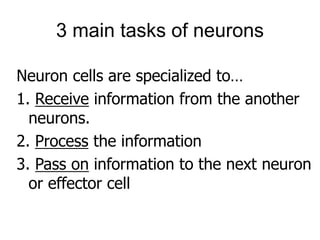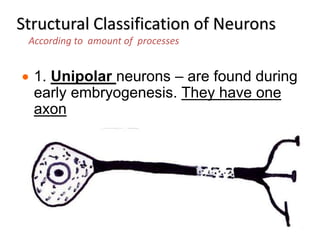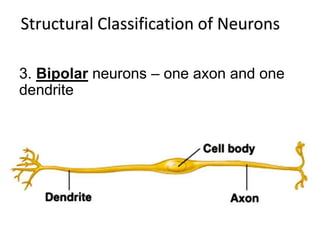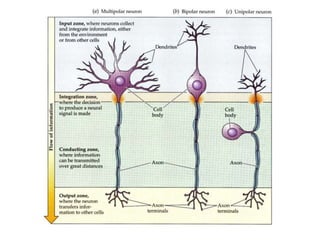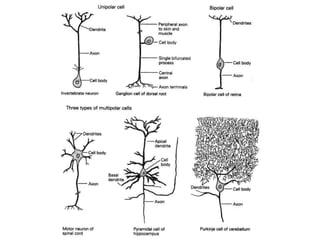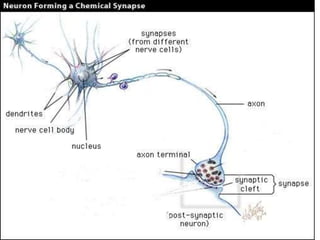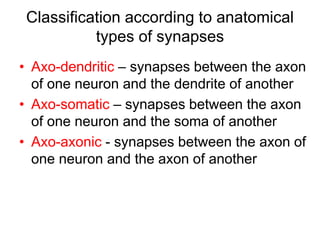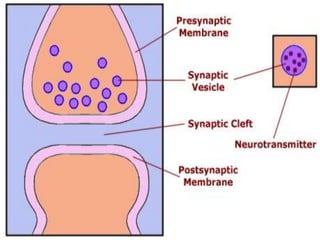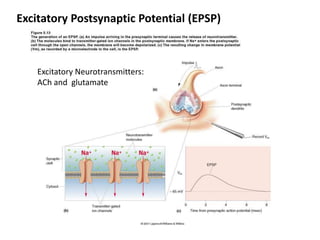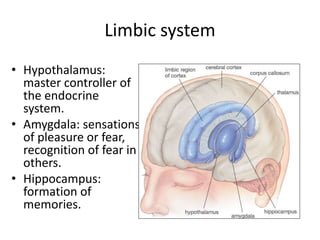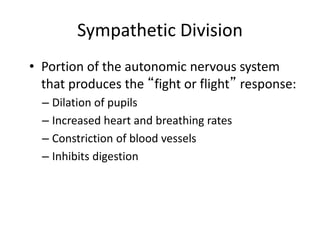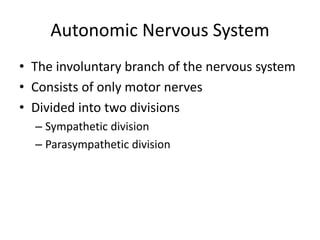nervous Physiology
- 1. NERVOUS SYSTEM PHISIOLOGY OF NERVOUS TISSUES. SYNAPSES. LECTURE
- 2. Lecture outline 1. Organization of nervous system 2. Neuron, neuroglia, classification and properties of nerve fiber 3. Electrophysiology, action potential, nerve impulse, synapse, neurotransmitters 4. Central nervous system: structure and functions of brain (cerebrum, brain stem, cerebellum) 5. Central nervous system: spinal cord (gross structure, functions of afferent and efferent nerve tracts, reflex activity) 6. Peripheral nervous system 7. Autonomic nervous system
- 3. Nervous System • Master controller and communicating system in the body • Every thought, action and emotion reflects its activity. • It signals the body through electrical impulses that communicate with the body cells.
- 5. • complex nervous system that consists of – A central nervous system (CNS) where integration takes place; this includes the brain and a nerve cord – A peripheral nervous system (PNS), which carries information into and out of the CNS – The neurons of the PNS, when bundled together, form nerves
- 6. The Nervous System Is Composed of Cells • Types of cells in the nervous system: – Neurons, or nerve cells – Glial cells provide support for neurons • Microglia • Astrocytes • Oligodendrocytes • Schwann cells
- 7. NEURON About how many neurons are in the human brain? 100 billion 1 billionAbout how many neurons are in the spinal cord?
- 8. Nervous Tissue: Neurons Copyright © 2003 Pearson Education, Inc. publishing as Benjamin Cummings Neurons = nerve cells -Cells specialized to transmit messages Major regions of neurons -Cell body – nucleus and metabolic center of the cell -Processes – fibers that extend from the cell body (dendrites and axons) -Axonal terminals
- 9. Neuron Anatomy Copyright © 2003 Pearson Education, Inc. publishing as Benjamin Cummings
- 10. Neuron cells are specialized to… 1. Receive information from the another neurons. 2. Process the information 3. Pass on information to the next neuron or effector cell 3 main tasks of neurons
- 11. Classifications of Neurons 1. According to Function a. sensory neurons (afferent neurons) b. motor neurons (efferent neurons) c. interneurons
- 12. THE THREE FUNCTIONAL CLASSES OF NEURONS
- 13. Classifications of Neurons 2. According to Structure 1. unipolar 2. pseudounipolar 3. bipolar 4. multipolar ( M. can be pyramidal, stellate, basket, granule, etc.)
- 14. Structural Classification of Neurons According to amount of processes 1. Unipolar neurons – are found during early embryogenesis. They have one axon
- 15. Structural Classification of Neurons 2. Pseudounipolar neurons – have a short single process leaving the cell body
- 16. Structural Classification of Neurons 3. Bipolar neurons – one axon and one dendrite
- 17. Structural Classification of Neurons 4. Multipolar neurons – many extensions from the cell body
- 20. Classifications of Neurons 3. According to Effect 4. According to Axon length a. excitatory neurons b. -inhibitory neurons -excitatory neurons -projection neurons (Golgi Type I) -local neurons (Golgi Type II) 5. According to Neurochemical identity e.g., cholinergic, dopaminergic, GABAergic, etc.
- 21. Nerve cell action potential
- 22. How are neurons connected? Synapses!!
- 23. What is a synapse? Synapse is a specialized junction that transfers nerve impulse information between neurons or between neuron and an effector cell
- 25. Functional classification or types of communication Chemical synapses Electrical synapses
- 26. CHEMICAL SYNAPSE • Almost all synapses used for signal transmission in the CNS of human being are chemical synapses. • First neuron secretes a chemical substance called neurotransmitter at the synapse to act on receptor on the next neuron to excite it, inhibit or modify its sensitivity.
- 27. Classification according to anatomical types of synapses • Axo-dendritic – synapses between the axon of one neuron and the dendrite of another • Axo-somatic – synapses between the axon of one neuron and the soma of another • Axo-axonic - synapses between the axon of one neuron and the axon of another
- 28. Axo-dendritic synapse Axo-somatic synanpse Axo-axonic synapse
- 29. How many synapses are in one neuron? 1,000 to 10,000!!
- 30. Structure of a chemical synapse A synapse consists of 3 elements: Presynapse or presynaptic part: The part that elicits the stimulus. Postsynapse or postsynaptic part: The part that receives the stimulus. Synaptic cleft: The space between the two structures.
- 32. Steps of the synaptic transmission
- 33. Excitatory Postsynaptic Potential (EPSP) Excitatory Neurotransmitters: ACh and glutamate
- 34. Inhibitory Postsynaptic Potential (IPSP) Inhibitory Neurotransmitters: Glycine and GABA
- 35. Neurotransmitter Recovery and Degradation • Neurotransmitters must be cleared from the synapse to permit another round of synaptic transmission. • Methods: – Diffusion – Enzymatic degradation in the synapse. – Presynaptic reuptake followed by degradation or recycling. – Uptake by glia – Uptake by the postsynaptic neuron and desensitization.
- 36. Neurotransmitters • There are dozens of different neurotransmitters (NT) in the neurons of the body. • NTs can be either excitatory or inhibitory • Each neuron generally synthesizes and releases a single type of neurotransmitter
- 37. Major Neurotransmitters in the Body Neurotransmitter Role in the Body Acetylcholine A neurotransmitter used by the spinal cord neurons to control muscles and by many neurons in the brain to regulate memory. In most instances, acetylcholine is excitatory. Dopamine The neurotransmitter that produces feelings of pleasure when released by the brain reward system. Dopamine has multiple functions depending on where in the brain it acts. It is usually inhibitory. GABA (gamma-aminobutyric acid) The major inhibitory neurotransmitter in the brain. Glutamate The most common excitatory neurotransmitter in the brain. Glycine A neurotransmitter used mainly by neurons in the spinal cord. It probably always acts as an inhibitory neurotransmitter. Norepinephrine Norepinephrine acts as a neurotransmitter and a hormone. In the peripheral nervous system, it is part of the flight-or-flight response. In the brain, it acts as a neurotransmitter regulating normal brain processes. Norepinephrine is usually excitatory, but is inhibitory in a few brain areas. Serotonin A neurotransmitter involved in many functions including mood, appetite, and sensory perception. In the spinal cord, serotonin is inhibitory in pain pathways. NIH Publication No. 00-4871
- 38. FACTORS EFFECTINF SYNAPATIC TRANSMISSION: DRUGS Many drugs are known to increase the excitability of neurons, and others are known to decrease excitability. For instance, Caffeine, Theophyline, Theobromine, which are found in coffee, tea, and cocoa, respectively. All increase neuronal excitability, presumably by reducing the threshold for excitation of neurons.
- 39. Electrical Synapses • Pre- and postsynaptic neurons joined by gap junctions – allow local current to flow between adjacent cells. Connexons: protein tubes in cell membrane. • Rare in CNS or PNS • Found in cardiac muscle and many types of smooth muscle. Action potential of one cell causes action potential in next cell, almost as if the tissue were one cell. • Important where contractile activity among a group of cells important.
- 40. Two principal kinds of synapses: electrical and chemical
- 41. Central Nervous System • Consists of brain and spine • Functions: – Receives sensory signals and determines appropriate response – Stores memory – Carries out thought
- 42. Brain
- 43. The Complex Brain • The mammalian brain is highly complex, containing many specialized regions that carry out specific functions. • Generally, the brain is divided into hindbrain, midbrain, and forebrain.
- 44. Brain: Structure • Forebrain processes signals, stores memories, creates thought. • Midbrain coordinates signals. • Hindbrain carries out the most basic functions.
- 45. Forebrain • Thalamus: relay station channeling sensory information. • Limbic system: basic emotions, drives, and behaviors. • Cortex: higher thought
- 46. Limbic system • Hypothalamus: master controller of the endocrine system. • Amygdala: sensations of pleasure or fear, recognition of fear in others. • Hippocampus: formation of memories.
- 47. Cortex • Various areas control sensory processing, motor control, thought, memory. • Wiring is plastic: people blind from birth, for example, use parts of the visual cortex to process auditory signals.
- 48. Midbrain • Reticular formation: the “traffic cops” of the brain. • Filters sensory input, which allows us to concentrate. • Filtering can be affected by higher thoughts.
- 49. Midbrain • Mostly composed of tracts of nerve fibers • Has two bulging fiber tracts – cerebral peduncles • Has four rounded protrusions – corpora quadrigemina – Reflex centers for vision and hearing
- 50. Try this: • Stop and think: What have you been paying attention to for the last ten minutes? • Pay attention to the feel of your shirt on your arms. Had you been noticing it during the last ten minutes? That’s the reticular formation in action. • What else have you not been paying attention to?
- 51. Hindbrain Medulla: controls autonomic fuctions. Pons: controls sleep stages. Cerebellum: coordinates movement, stores some motor memory.
- 52. Spine: structure • The spinal cord is protected by the vertebrae. • Gray matter contains cell bodies; white matter contains myelinated fibers. • PNS nerves extend outside of the vertebrae.
- 53. The Reflex Arc Copyright © 2003 Pearson Education, Inc. publishing as Benjamin Cummings Reflex – rapid, predictable, and involuntary responses to stimuli Reflex arc – direct route from a sensory neuron, to an interneuron, to an effector
- 54. Types of Reflexes and Regulation • Autonomic reflexes – Smooth muscle regulation – Heart and blood pressure regulation – Regulation of glands – Digestive system regulation • Somatic reflexes – Activation of skeletal muscles
- 55. Peripheral Nervous System • Nerves, neurons, and sensory organs outside the central nervous system • Functions: – Sends signals to the CNS – Receives and transmits motor signals from the CNS – Stimulates effectors
- 56. Somatic Nervous System • Motor neurons that control voluntary movements by activating skeletal muscles. • Also involved in what we perceive as involuntary movements, such as reflexes (though voluntary control of the muscles involved, such as tensing them, can reduce the response).
- 57. Autonomic Nervous System • Motor neurons that control involuntary responses involving the organs, glands, and smooth muscles. • Some voluntary control over the responses can come from relaxation, meditation, etc., which reduce perceptions of stress and in turn reduce the stress response.
- 58. Sympathetic Division • Portion of the autonomic nervous system that produces the “fight or flight” response: – Dilation of pupils – Increased heart and breathing rates – Constriction of blood vessels – Inhibits digestion
- 59. Parasympathetic Division • Portion of the autonomic nervous system that produces the “rest and ruminate” response: – Constricts pupils – Dilates blood vessels – Reduces heart and breathing rates. – Stimulates digestion.
- 60. Freeman 45-20
- 61. Autonomic Nervous System • The involuntary branch of the nervous system • Consists of only motor nerves • Divided into two divisions – Sympathetic division – Parasympathetic division
- 62. Differences Between Somatic and Autonomic Nervous Systems • Nerves –Somatic – one motor neuron –Autonomic – preganglionic and postganglionic nerves • Effector organs –Somatic – skeletal muscle –Autonomic – smooth muscle, cardiac muscle, and glands
- 63. Differences Between Somatic and Autonomic Nervous Systems • Nerurotransmitters –Somatic – always use acetylcholine –Autominic – use acetylcholine, epinephrine, or norepinephrine
- 64. Comparison of Somatic and Autonomic Nervous Systems
- 65. QUESTIONS 1. Functions and Divisions of the Nervous System. 2. Neurons. The important structural components and their functional role. 3. Classification of Neurons. Structural and functional classification. 4. Synapses. Classification of synapses. 5. Structure of a chemical synapse. 6. Steps of the synaptic transmission. 7. Types of neurotransmitters. 8. Excitatory postsynaptic potential. Inhibitory postsynaptic potential. 9. Electrical synapses. 10. Central nervous system: structure and functions of brain (cerebrum, brain stem, cerebellum) 11. Central nervous system: spinal cord (gross structure, functions of afferent and efferent nerve tracts, reflex activi 12. Peripheral Nervous System. 13. Autonomic Nervous System: sympathetic and parasympathetic components.









